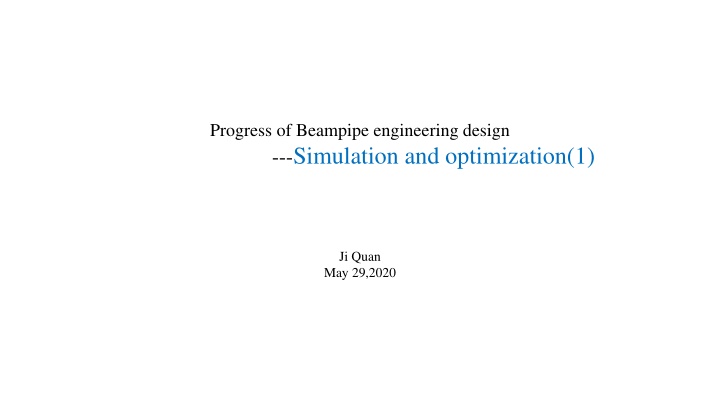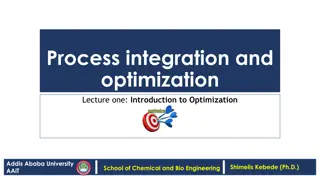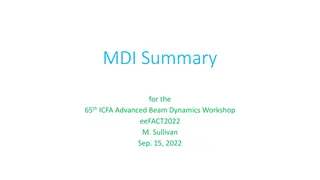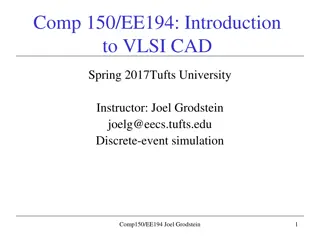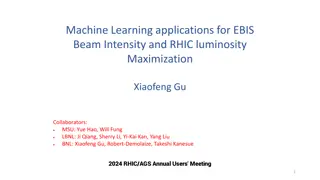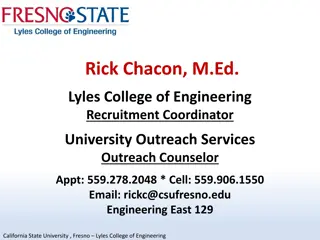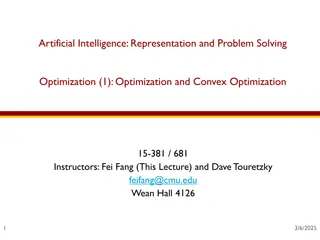Beampipe Engineering Design: Simulation and Optimization Update
This update covers the progress in beampipe engineering design including layout updates, thermal-hydraulic estimation, structure optimization, and preliminary design of Lumical. Details include modifications made, heat load calculations, structure optimization, and simulation results for the temperature field.
Download Presentation

Please find below an Image/Link to download the presentation.
The content on the website is provided AS IS for your information and personal use only. It may not be sold, licensed, or shared on other websites without obtaining consent from the author.If you encounter any issues during the download, it is possible that the publisher has removed the file from their server.
You are allowed to download the files provided on this website for personal or commercial use, subject to the condition that they are used lawfully. All files are the property of their respective owners.
The content on the website is provided AS IS for your information and personal use only. It may not be sold, licensed, or shared on other websites without obtaining consent from the author.
E N D
Presentation Transcript
Progress of Beampipe engineering design ---Simulation and optimization(1) Ji Quan May 29,2020
Contents: 1. Layout of Beampipe and Design Update 2. Thermal-hydraulic estimation 3. Structure Optimization of Vertex 4. Preliminary Design of LumiCal 5. Summary and Plan
1. Layout of Beampipe and Design Update A: Carbon fiber cylinder C: The central Be pipe D: The extending Al pipe B: Air channel vertex LumiCal Progress and update: (compared with Ver. 20200116) 1) No modification for the general layout a. comprised of 4 components: A B C D b. To support 2 detectors: Vertex and LumiCal Conclusion The dimension of Beampipe is within of bounds of detector angle arcCOS0.99 2) According to the design requirements of LumiCal, the length of the Beampipe is increased from 1400mm to 1500mm. 3) According to the calculation of the heat load provided by accelerator, the cooling design of Beampipe has been checked. 4) The structure design has been optimized, and feasibility of air cooling has been calculated. 5) Preliminary engineering of LumiCal has been carried out.
2. Thermal-hydraulic estimation Vacuum pipe size of beampipe: beryllium aluminum aluminum aluminum aluminum stainless steel stainless steel Transition section (No Cooling) The estimated heat load is as follows: Total thermal power : (only High order mode heat ) 453.26+136.72+453.26 = 1043.24 (W) Because of the high power of the thermal load, the double-layer cooling structure must be designed to ensure the working temperature of the beam pipe
The whole temperature field is simulated by the length 1400mm three-dimensional model, see the figure bellow. The initial conditions for calculation are as follows: SS304L Be Al Al SS304L Coolant: water, 2 inlet,2 outlet Coolant: paraffin, four inlet, four outlet Coolant: water, 2 inlet,2 outlet Inlet temperature: 23 Inlet velocity: 2m/s Inlet temperature: 23 Inlet velocity: 0.6m/s Inlet temperature: 23 Inlet velocity: 2m/s Total heat W 136.72 453.26 Area m2 2.2e-2 1.02E-01 Heat flux W/cm2 0.63 0.45 Be Al
The calculation results are as follows Temperature distribution of beam pipe: Maximum temperature:28.9 Paraffin inlet Paraffin outlet Temperature distribution of Be pipe cross section(z=113mm) Maximum temperature of transition section: 35 Maximum temperature of transition section: 40 Maximum temperature of transition section: 70 Maximum temperature of transition section: 70 Conclusion: 1. Where there is double cooling structure, the temperature is low 2. Where there is no double cooling structure, the temperature is high
Detail structure 400+550+550=1500 mm Central Be pipe: inlet outlet inner Be: T=0.50mm L=400mm(240+80+80) D(inner)= 28mm gap: T=0.50mm outer Be: T=0.35mm L=230mm D(inner)= 30mm Coolant: paraffin
Extending Al pipe: outlet inlet inner pipe: T=2.5mm gap: outer pipe: T=1.5mm T=1.0mm Coolant: water
3. Cooling Structure Optimization of Vertex 1) Optimization of air cooling channel --- We only optimized the design scheme of parallel and stratified flow Air Outlet Air Inlet (4- 6) Ver. 20200116 Air Inlet (4- 12) Air Outlet Ver. 20200529 a. Optimization of outlet and inlet of air duct Location of wind outlet and inlet: moved from inside to both ends for easy installation of air duct Diameter of air inlet and outlet: increased from 6mm to 12mm, to improve the wind speed flowing on the chip surface
b. Optimization of the first layer layout From single layer layout to double layer layout Purpose: to provide air channel for inner silicon chip of the first layer
2) Feasibility calculation of air cooling In pursuit of low material budget, the best way to cool the silicon detector is by air cooling, However, due to the tight space, the wind speed required for cooling cannot be provided. The poor air cooling effect is also due to the poor heat conduction effect of carbon fiber materials. So, coating graphene on the surface of carbon fiber can effectively improve the heat dissipation effect and reduce the surface working temperature of the chip For the wind speed that can be provided under the beam tube structure Very low (Wind speed is inversely proportional to area) 12 Vertex cavity cross section Duct inlet area Effective area Sectional area Actual speed m/s 0.33 0.68 Sectional area ID speedNumber flow OD ID m3/min mm2 0.203 0.407 mm 6 12 m/s 15 15 mm mm 30.7 30.7 mm2 1.06E+04 1.02E+04 m2 8 4 226.08 120 452.16 118 1.03E+04 9.91E+03 45 22
Simulation model : Si 257mm*12.8mm*0.05mm*10 698mm*16.8mm*0.1mm 698mm*16.8mm*0.07mm 698mm*16.8*0.2mm Air cooling model Graphene heat conducting layer model Results are as follows Maximum temperature The thermal conductivity of graphene 1700 The thermal conductivity of graphene 5000 Heat flow density Air cooling (No graphene) Calculation conditions Carbon fiber length: 698mm Air velocity:0.3m/s Graphene coating thickness:0.1mm mW/cm2 200 537.9 186.6 103.7 100 276.7 103.2 62 61.6 50 146.6 41
2) Detailed design of the carbon fiber supporting structure The section shape and parameters of carbon fiber support structure are as follows: Flexible plate (double) Silicon chip Thickness of vertical section 0.2mm Thickness of horizontal section: 0.1mm Width: 16.8mm carbon fiber support structure We have compared the thickness of various sections. The vertical thickness of 0.2mm and the horizontal thickness of 0.1mm are the best results. Detection unit of the Vertex consists of two flexible plates and a carbon fiber supporting bar
Optimization results of the first layer of carbon fiber bars: length 314mm Initial conditions for calculation: height :1.5mm, Loading: self weight, Loading: 2.7g(Weight of flexible plate) deformation 0.02mm
Optimization results of the second layer of carbon fiber bars: length 488mm Initial conditions for calculation: height :2mm, Loading: self weight, Loading: 5.3g(Weight of flexible plate) deformation 0.033mm
Optimization results of the third layer of carbon fiber bars: length 698mm Initial conditions for calculation: height :3.5mm, Loading: self weight, Loading: 8g(Weight of flexible plate) deformation 0.05mm
Detailed structure and dimensions --- Vertex Detailed dimensions of the first layer of carbon fiber bars Detailed dimensions of second and third layer carbon fiber bars
Detailed structure and dimensions --- Carbon fiber cylinder Thickness:1.5mm This is a key component, which can strengthen the beam pipe and form the air channel for cooling vertex
4. Preliminary Design of LumiCal B:Vertical detector of LumiCal(Si) A:axial detector of LumiCal C:Vertical detector of LumiCal(Si-W) Difficulty: In order to increase the air cooling effect of vertex, the detector of LumiCal is sealed inside, which increases the design difficulty of heat dissipation and outgoing cable
D: The extending Al pipe C: The central Be pipe B: Air channel A: Carbon fiber cylinder vertex LumiCal Ver. 20200529
5. Summary and Plan Summary 1) The dimension of Beampipe is within of bounds of detector angle arcCOS0.99 2) According to the cooling simulation of Beampipe the present design can handle1kW power dissipation 3) The cooling design of Vertex still needs optimization. Increasing the heat transfer coefficient might be an optional choice for the optimization. Suggestion: to develop graphene layer on the flexible circuit board and on the carbon fiber supporting structure. Plan: Move forward in the engineering design for TDR based on CDR, to provide baseline for future design. 1) to improve the engineering design of Beampipe, including Vertex and LumiCal. 2) to carry out design of the other detectors.
